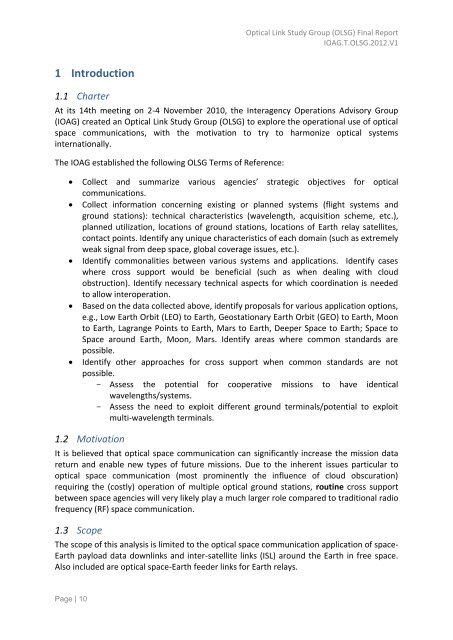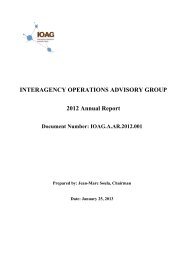OLSG Report_Final_06_05_12 - Interagency Operations Advisory ...
OLSG Report_Final_06_05_12 - Interagency Operations Advisory ...
OLSG Report_Final_06_05_12 - Interagency Operations Advisory ...
Create successful ePaper yourself
Turn your PDF publications into a flip-book with our unique Google optimized e-Paper software.
Optical Link Study Group (<strong>OLSG</strong>) <strong>Final</strong> <strong>Report</strong><br />
IOAG.T.<strong>OLSG</strong>.20<strong>12</strong>.V1<br />
1 Introduction<br />
1.1 Charter<br />
At its 14th meeting on 2-4 November 2010, the <strong>Interagency</strong> <strong>Operations</strong> <strong>Advisory</strong> Group<br />
(IOAG) created an Optical Link Study Group (<strong>OLSG</strong>) to explore the operational use of optical<br />
space communications, with the motivation to try to harmonize optical systems<br />
internationally.<br />
The IOAG established the following <strong>OLSG</strong> Terms of Reference:<br />
Collect and summarize various agencies’ strategic objectives for optical<br />
communications.<br />
Collect information concerning existing or planned systems (flight systems and<br />
ground stations): technical characteristics (wavelength, acquisition scheme, etc.),<br />
planned utilization, locations of ground stations, locations of Earth relay satellites,<br />
contact points. Identify any unique characteristics of each domain (such as extremely<br />
weak signal from deep space, global coverage issues, etc.).<br />
Identify commonalities between various systems and applications. Identify cases<br />
where cross support would be beneficial (such as when dealing with cloud<br />
obstruction). Identify necessary technical aspects for which coordination is needed<br />
to allow interoperation.<br />
Based on the data collected above, identify proposals for various application options,<br />
e.g., Low Earth Orbit (LEO) to Earth, Geostationary Earth Orbit (GEO) to Earth, Moon<br />
to Earth, Lagrange Points to Earth, Mars to Earth, Deeper Space to Earth; Space to<br />
Space around Earth, Moon, Mars. Identify areas where common standards are<br />
possible.<br />
Identify other approaches for cross support when common standards are not<br />
possible.<br />
- Assess the potential for cooperative missions to have identical<br />
wavelengths/systems.<br />
- Assess the need to exploit different ground terminals/potential to exploit<br />
multi-wavelength terminals.<br />
1.2 Motivation<br />
It is believed that optical space communication can significantly increase the mission data<br />
return and enable new types of future missions. Due to the inherent issues particular to<br />
optical space communication (most prominently the influence of cloud obscuration)<br />
requiring the (costly) operation of multiple optical ground stations, routine cross support<br />
between space agencies will very likely play a much larger role compared to traditional radio<br />
frequency (RF) space communication.<br />
1.3 Scope<br />
The scope of this analysis is limited to the optical space communication application of space-<br />
Earth payload data downlinks and inter-satellite links (ISL) around the Earth in free space.<br />
Also included are optical space-Earth feeder links for Earth relays.<br />
Page | 10



